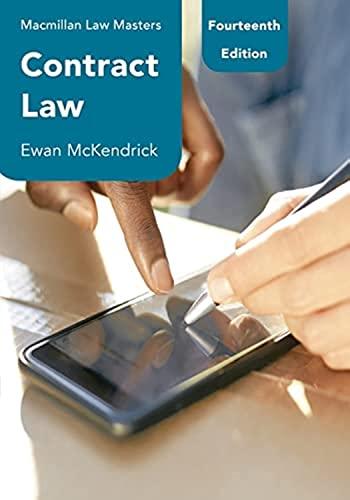Question
ASSIGNMENT: Review the facts of the Sam Kant case from Memo One. For this assignment, Mr. Kant stands charged with petit larceny rather than shoplifting.
ASSIGNMENT: Review the facts of the Sam Kant case from Memo One. For this
assignment, Mr. Kant stands charged with petit larceny rather than shoplifting. Please
thoroughly apply the law provided below, based on your lessons and reading material
regarding legal analysis and writing. In preparing your memorandum, please consult the
sample Legal Memorandums from PCD and Statsky. Discuss whether or not you think
Mr. Kant could be convicted of petit larceny pursuant to the law provided. Please note,
this is a closed memo and no outside research should be conducted. Apply only the law
as provided below.
For the purposes of this assignment, Sam Kant stands charged with Petit Larceny under
Criminal Statute 143.03(a) which provides the following:
A person is guilty of petit larceny when he deprives the owner of property.
Petit larceny is a class "A" misdemeanor
Criminal Statute 143.00 Larceny; Defined
(1) A person steals property and commits larceny when, with intent to deprive
another of property, or to appropriate the same to himself, he wrongfully takes, obtains
or withholds such property from an owner thereof.
In State v. Gross (2001) the defendant moved for dismissal of petit larceny charges
because he had not yet left the store with the merchandise in his possession.
Defendant, Gross, removed 2 rib eye steaks from the plastic wrapping in which they
were encased, placing them below his shirt and under each armpit, and was
apprehended after having passed the last point of purchase, but prior to reaching the
exit doors.
The court held that: (1) a defendant demonstrates the requisite intent to
deprive an owner when he acts in a manner that is contrary to those which would be
undertaken by an ordinary person, under ordinary circumstances for the situation
involved, and (2) actions that are inconsistent with and are ultimately adverse to the
owner's interest may be enough to establish guilt beyond a reasonable doubt, and (3)
the nature of these acts may be enough to establish guilt beyond a reasonable doubt
despite the defendant not having left the premises.
Step by Step Solution
There are 3 Steps involved in it
Step: 1

Get Instant Access to Expert-Tailored Solutions
See step-by-step solutions with expert insights and AI powered tools for academic success
Step: 2

Step: 3

Ace Your Homework with AI
Get the answers you need in no time with our AI-driven, step-by-step assistance
Get Started


